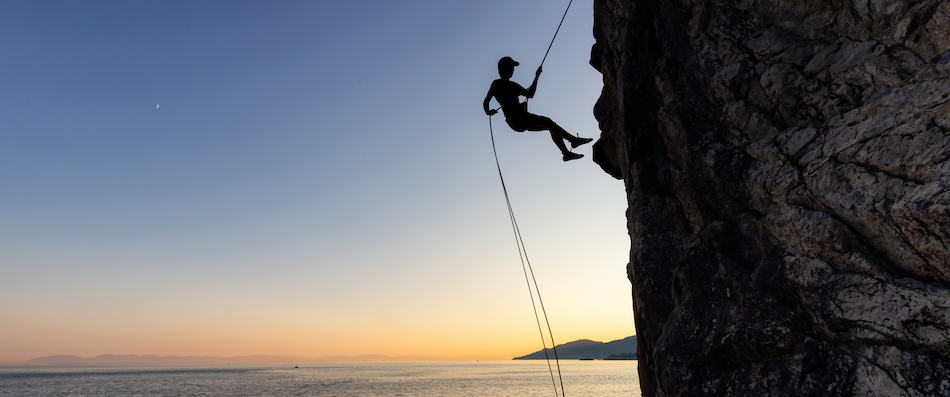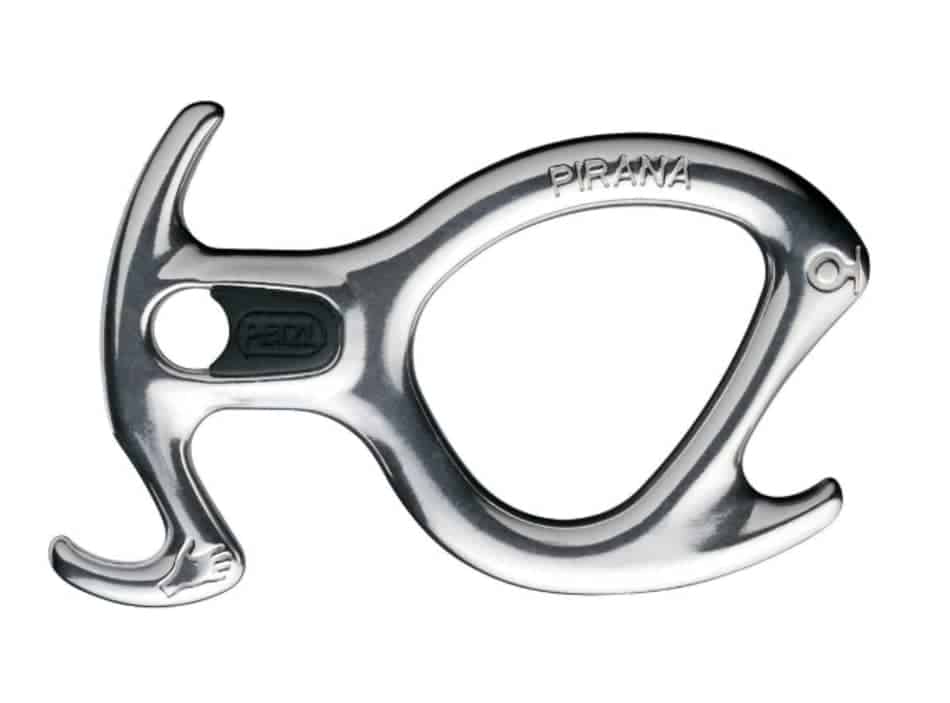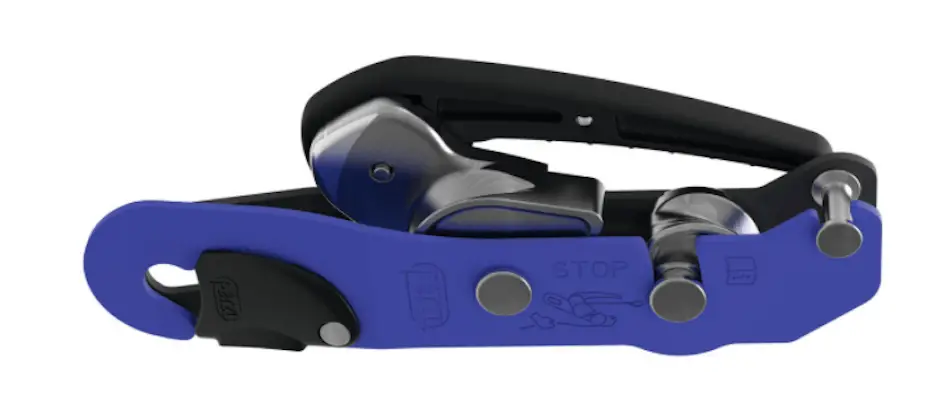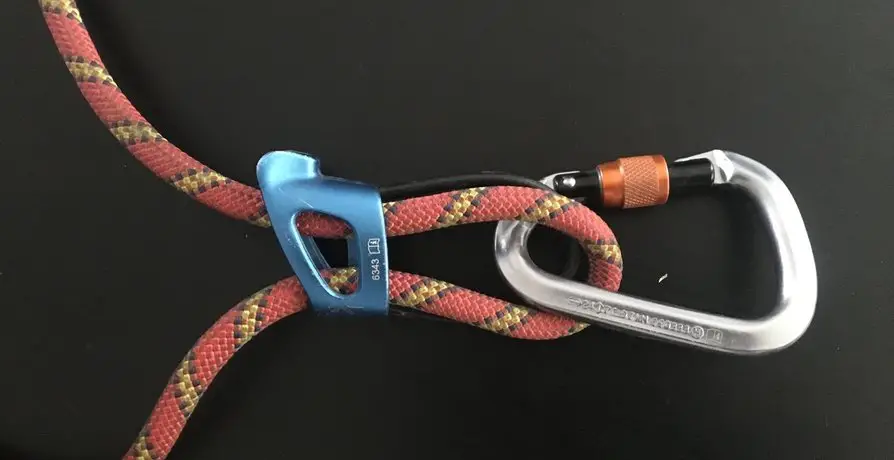
There are a lot of different rappel devices on the market. Choosing which one to use can be a confusing and difficult process, so I’ve made the following guide to help you make your decision.
Picking a rappelling device is a little bit different than picking a belay device. The top devices for rappelling are:
- The Petzl PIRANA
- Sterling ATS
- Petzl Stop Designer
- The Edelrid Giga Jul
- The SQWUREL 2
- The Black Diamond ATC
These devices are good for different uses. For example, some of them are built for all-around use, while others have very specific functions and may not work as well as generalists. In the following article I’m going to break down the scenarios where you may choose one of these devices, along with their pros/cons.
When judging the devices, I’m looking at a variety of factors including how well they allow you to control the rappel, how easy they are to operate, and how durable they are. All of the information in this review comes from personal experience and in-depth research that I’ve done to try and find the best single device for you to use while rappelling.
The Winners
So, without further ado, the best devices for rappelling are:
The Petzl PIRANA: The PIRANA is the single best rappel device on the market right now. It’s affordable, packable, easy to use, and super durable. It has six different friction levels for dealing with more technical terrain.
The Sterling ATS: A device that’s pretty good at everything but not the best at anything, the Sterling ATS has a few fundamental flaws that were detrimental to it not being #1 on this list. It’s mid-air friction variation and belay compatibility, however, win it the number two spot.
The Petzl Stop Descender: This device is the ultimate specialist. For single-strand rappels, there’s no other device than can compete with its security, ease of use, and durability. A lack of use in other areas, however, knocked it down a couple of spots.
The Edelrid Giga Jul: For people who put rock climbing first and rappelling second, the Giga Jul is the closest thing that the world has ever seen to a true all-arounder. Plus, it rappels better than other mechanical devices.
The SQWUREL 2: When canyoneering, you sometimes need something a little more technical. The SQWUREL combined mid-air adjustability with a smooth lowering feel to be the best canyon device.
The Black Diamond ATC: Father time once fought the ATC and lost. Despite an influx of new devices, the ATC remains the most versatile device on the market. For all-around alpinists who need a rappel device, nothing even comes close.
Best Device: The Petzl PIRANA

Price: $39.95
Where to Buy: https://www.petzl.com/US/en/Sport/Belay-devices-and-descenders/PIRANA
Pros:
- Affordable price from a trusted manufacturer
- Smooth design allows for the PIRANA to be attached to the rope without needing to disconnect from your harness.
- Variable friction levels provide adequate adjustability pre-rappel
Cons:
- Fewer features than other devices
- Fewer friction levels can be added mid-rappel.
Verdict:
The Petzl PIRANA is my winner for the best overall rappel device. It’s got a little bit of everything, avoids going overboard in any one area, and caps it off with a simple-yet-durable design. It’s also one of the cheapest devices that we’re going to look at; when combined with its durability, this solidifies its position as the #1 rappel device on the market right now.
What I like most about the Petzl PIRANA is that it has just enough features to make it capable of performing technical rappels, without having a confusing array of gimmicks that can make it difficult to handle.
In terms of technical performance, the PIRANA has six different levels of friction that it can provide, depending on how technical the rappel is and what kind of terrain you’re dealing with. If you’re completing a steep, overhanging rappel, if can notch up the resistance to give yourself more control; if you’re looking to get down in a hurry, you can keep the friction a little lower and get down easier. This is in contrast to more basic devices such as an ATC, where the only control you have is how tightly you grip the rope.
Additionally, the PIRANA allows you to make these adjustments mid-air. This is a huge advantage for activities such as canyoning, where you’re going to face different types of terrain in one rappel. If you want to keep the rappel looser while you lower yourself off an edge and then tighten it up once you’re free hanging, the PIRANA gives you this ability. You can also tie off the rappel, too, if you need to rest halfway through.
Another huge advantage of the PIRANA is the fact that it can handle two-strand rappels, which makes it versatile in a whole host of areas. This makes it useful for descending multi-pitch routes or sport climbing crags where you don’t want to have to bother with setting up a tagline.
I’ve spent a lot of time talking about the strengths of the PIRANA, so let’s touch on some of the weaknesses now. The PIRANA is a generalist; this is one of its biggest strengths, but it can also be a weakness. In almost no situation is the PIRANA going to be the best device for what you’re doing, and there will often be something out there that can perform a specific feature better than it.
However, if someone told me that they wanted to go rappelling and needed to buy one device to act in a variety of situations, I would recommend the PIRANA — and that earns it the top spot on this list.
Best of the Rest: The Sterling ATS and the Petzl Stop Descender
This was a close-fought race, and these two devices could have well deserved to be number one. Let’s look at them in more detail.
The Sterling ATS

Price: $39.95
Where to Buy: https://www.amazon.com/Sterling-Rope-Device-Black-8-Inch/dp/B004MXCPRW/ref=cm_cr_arp_d_product_top?ie=UTF8
Pros:
- Two-slot design allows for easy double-rope rappelling
- Middle slot also allows the device to be used for belays
- Four horns give varying friction levels mid-rappel
Cons
- Smaller carabiner hole only fits specialized equipment.
- Generalist design lacks some of the features of the above devices
- Soft metal wears quickly when faced with sand and water
Verdict:
The Sterling ATS comes so close to being the best rappel device ever invented, if it weren’t for a few fundamental flaws.
First, let’s talk about what the ATS has going for it. Obviously, it has enough good things to land it in second place on this list, and the ATS is a well-designed piece of equipment that’s built for rappellers.
First of all, it’s got the ability to perform dual-strand rappels, which (as I mentioned above) is basically a prerequisite for being one of the best rappel devices. Next, it’s got the four ‘horns’ on the main body that allow for varying levels of friction to be added mid-rappel, so you get the same advantages that I listed for the PIRANA.
The main advantage that the Sterling ATS has going for it, however, is that it can double as a belay device. It’s really the only device on the market right now that’s made by a trusted manufacturer that allows for complex rappelling techniques while also functioning as a belay device. This would put the ATS in a category of its own— if it wasn’t for all of the drawbacks that came with it.
First is the design. The wide, flat shape, capped on every corner by a horn, makes it bulky and awkward to carry. It has poor ergonomics, and it can get in your way if you’re trying to feed rope on a belay.
More importantly, though, the ATS has some fundamental flaws in the way it’s made. The first, and maybe the most egregious, is its carabiner hole, which is too narrow to accept most standard carabiners.
Let me say that again, because it’s almost too ridiculous to be true: the hole in the device specifically designed to hold carabiners is too narrow to fit most carabiners.
Requiring you to purchase specific equipment just to perform basic functions is offensive, and that feature alone is enough to knock it from the top spot. The ATS, however, has one other flaw: it’s not as durable as the other devices. The ATS is built out of a soft aluminium compound, which serves to make it more portable for fast-and-light alpine missions.
This lightness, however, comes at the cost of durability. Especially if you’re rappelling in environments where you’re going to be encountering sand and water, or other coarse materials, the ATS wears down quickly in areas that experience a lot of friction.
The ATS is sort of like the promising child who failed to fully live up to expectations. At first glance, it should be the only rappelling device you’ll ever need— but dig a little deeper and it unfortunately doesn’t stack up against some of the other devices.
The Petzl Stop Descender

Price: $189.95
Where to buy: https://www.mec.ca/en/product/6001-793/Stop-Descender
Pros:
- Auto-locking feature will catch you if you let go
- Solid, durable design
- Works with wet, muddy, clogged ropes
Cons:
- Expensive
- Heavy and not intuitive to use
- Might be overkill for most rappels
There are rappel devices, and then there are rappel devices. The Petzl Stop Descender falls into the second category.
Built for cavers, canyoneers, and professionals alike, the Stop Descender is probably the most hardcore device out there. With its stainless-steel design, autolocking camming device, and deadmans switch to spot you if you take your hands off the device, it’s designed to ensure that you get to the bottom of the rope safely no matter what the circumstances might be.
In terms of what it does well, there’s a lot to love about this device. First of all, it’s absolute bomber. You don’t have to worry about breaking it, bashing it against rock, or accidentally dropping it off a cliff. Furthermore, for first time rappelers or those who are maybe less than thrilled at the idea of dangling their life off of a piece of rope, the Stop Descender feels really solid in your hand. It’s about 5 times heavier than most of the other devices on this list and it just looks a whole lot sturdier than something like the PIRANA.
The Stop Descender also has a ‘dead man’s switch’ that will arrest your descent if anything happens to you on the way down. This essentially means that you have to hold a handle down for rope to pass through the device; if you stop doing so, the device will lock and you’ll be suspended mid-air.
This can be a nice little safety feature if you’re tired after a long day or don’t trust your own ability to hold on to the rope. Additionally, it protects you against natural hazards: if you get hit by a rock while rappelling and become unable to operate the device, the Descender will prevent you from falling to the end of your rope.
Finally, the Petzl Descender might be the best device out there for handling wet, dirty, or mud-clogged ropes. Because of the internal camming devices, you don’t have to worry about how the state of the rope will impact your ability to control the descent, as you might with a friction-based device like the PIRANA.
The main drawbacks of the Descender are how heavy it is and its limited ability to perform dual-strand rappels. Lugging around the Stop Descender all day if you don’t know for sure that you’ll have to rappel is a little excessive. Additionally, it can’t be used for belaying, so it’s not a multi-purpose device at all.
Additionally, like I mentioned, the Petzl Descender can only work for single-strand rappels with ropes that are between 9 and 11 millimetres, meaning it has limited functionality in a lot of instances.
The Petzl Stop Descender is almost on the opposite side of the spectrum from the Sterling ATS. The ATS is built as a more general device, and it does a pretty good job of doing multiple things. The Stope Descender, on the other hand, only does one thing, but it does it really really well.
If you find yourself in a situation where you think the Stop Descender is going to be useful, it can definitely justify the higher price and limited use. For more general use, however, you might want to look elsewhere.
Best Device for Climbers: The Edelrid Giga-Jul

Price: $59.95
You can buy it at: https://www.rei.com/product/150387/edelrid-giga-jul-belay-device
Pros:
- Works well for single pitch, multi-pitch, and trad climbing
- Functions as both an assisted braking and manual belay device
- Allows for more control on rappels
Cons:
- Unique design can take some getting used to
- No varying friction levels
Verdict:
If you’re a rock climbing, the chances are you’re already got a favourite device. You’ve read the reviews online, experimented with different brands, and dropped tons of money at REI; now, you can say with 100% certainty that you have found the best device for catching your partner and getting down the rope.
And then, to ruin all of your hard work, Edelrid came along and introduced the Giga Jul.
It all started a long time ago with the Jul, an innovative but flawed device introduced by a German company who was trying to break onto the scene in North America. Then came along the Mega Jul, a more innovative but somehow more flawed device that was mostly shunned by the climbing community.
Then, somewhere in 2018, Edelrid cracked the code: instead of using innovation to make the device better in some ways but worse in others (as they had when transitioning from the Jul to the Mega Jul), they instead decided to use innovation to improve the overall functionality of the Mega Jul. Thus, the Giga Jul was born.
The Giga Jul is like the new kid at school who can play sports better than everyone. It’s Billy from Stranger Things, who shows up one day and immediately takes over from the reigning prom king (thankfully, the Giga Jul doesn’t have a pattern of abusive behaviour). It’s what Yosemite climbers dream of when they sleep, and it’s what every equipment company has been striving towards since Yvon Chouinard first invented the hex way back in 1964.
The thing about the Giga Jul is that it’s a generalist device, but it can perform any one function 95% as well as the specialists can. It’s not quite as good for belaying single-pitch sport routes as a gri-gri, but it’s the next best thing. It may be slightly bulkier to carry than an ATC, but it’s by a fraction of a pound. This thing is the next generation of belay devices, and I would highly, highly recommend picking one up.
So, now you know why the Giga Jul is the Next Best Thing in the climbing world, what makes it good for rappelling?
I’ve always said that the beauty in the Black Diamond ATC is that it can work in any scenario: single rope rappels, double rope rappels, taglines, hanging, you name it. The thing about the Giga Jul is it can do all of those things, but it also has the ability to add in an assisted-braking feature if you’re dealing with more technical terrain.
Say you’re rappelling down a route while collecting gear, or you want to lower yourself halfway before stopping to take some pictures. By using the assisted-braking mode on the Giga Jul, you can make it way easier to hold yourself in place with only one hand. If you don’t want that feature and simply want to get down the rope as quickly as possible, you can slide it into manual mode and lower as you would with an ATC.
The main weakness of the Giga Jul is that its design can take a little bit of getting used to. Playing out slack while lead belaying feels weird, and even rappelling with the auto-lock engaged will take some getting used to. These flaws are something that you can iron out in the climbing gym, however, and the pros of the device make it well worth the time it takes to get used to it.
The Giga Jul is a better belay device and a better rappel device than anything else on the market. For rock climbing, that makes it the top choice.
Best Device for Canyoneering: The SQWUREL 2

Price: $52.50 USD
You can buy it at: https://www.adventure.plus/shop/c/p/SQWUREL-2-x12765985.htm
Pros:
- Tail design allows for increasing/decreasing friction ‘on the fly’
- Improved rope retention nub allows for a shorter tail.
- Compact, narrow design reduces the chance of it catching on other pieces of equipment
Cons:
- More expensive than other devices
- Asymmetrical design can cause some difficulties for left-handed people.
Verdict:
Canyoneering is one of the more rappel-heavy activities out there. You’re going to spend a full day lowering past waterfalls, dangling off of cliffs, and walking backwards down steep sections of terrain. With this much rappelling required, it makes sense to have a device that’s slightly more tailored to your needs.
Enter the SQWUREL 2. This funky little device, named after its distinctive head and tail design, is the result of 3 years’ work and over 60 prototypes being built. The SQWUREL is cleverly designed to allow for easy on-again, off-again adjustments to your friction levels via the ‘tail’ at the end, which allow you to simply slip the rope over it to add some stopping power to your rappel.
The SQWUREL was built specifically for canyoneering, and it really shows. It’s not just the fact that it does everything the other devices do; it just does them better, and it requires less features to do so. In terms of rope control, no other device on this list can hold a candle to it. It’s got cleverly designed features, a streamlined look, and extra material in key friction areas. If used correctly, this device should last you well over 2000 rappels— and that alone makes it worth the price tag.
The device isn’t perfect, however. The main flaw I could find through my research was that the SQWUREL’s asymmetric design made it harder to use for people who are left-hand dominant. In one instance, a fellow set it up incorrectly too many times and ended up prematurely wearing out his device.
Gear wear is never good, and if you start to notice a decline in the quality of your device you should definitely invest in a new one. When used correctly, however, the SQWUREL 2 has ever feature you could want in a canyoneering rappel device.
Where this device won’t stack up, however, is for activities that require more than just rappelling. The SQWUREL isn’t set up to support belays, so it won’t help you if you ever need to go upwards. Additionally, it’s not as compact as something like the ATC, so carrying it on all-day missions as a backup isn’t ass practical. Finally, the SQWUREL 2 is a little confusing to use, so for first-time rappeler’s it might not be the best option.
Best Device for Generalists: The Black Diamond ATC

Price: $25.95
Where to buy: https://www.blackdiamondequipment.com/en_CA/search?cgid=belay-rappel
Pros:
- Best all-around device
- Works in just about every situation.
- Rugged and durable
Cons:
- No adjustability mid-rappel
- Higher chance of rope twist
- Less control
If I had to choose one rope-control device to rule them all, it would be the Black Diamond ATC.
Now, before I go too deeply into why I love this device, I first need to clear up what I mean by ‘all-around device’. When I say that the PIRANA is the best all-around rappel device, I mean it’s the best for different situations in which you’ll need to rappel. Whether you’re canyoning in Utah or lowering from a sport climb in Ceuse, the PIRANA will get you down the rope.
When I say all-around in regards to the ATC, however, I mean for every time of rope-related activity. If you told me you were going to spend a year climbing, mountaineering, caving, rappelling, and doing any other type of rope-related activity, I would tell you to bring the ATC along with you.
So, if you need one device to help you rappel, pick the PIRANA. If you need one device to perform a variety of tasks including rappelling, pick the ATC.
Now, I know what you’re thinking: didn’t I just say that the Giga Jul was the best device on the market? Didn’t I just say that, if the ATC was Steve Harrington, the Giga Jul was Billy? (Note: I’ve never seen Stranger Things).
Well, yes and no. The Giga Jul is the new kid on the block, and I’m going to need to see a lot more out of it before I’m willing to call it the best all-around device. It has the potential to take that title from the ATC, but it’s not quite there.
Additionally, the Giga Jul has yet to prove itself in an alpine environment. On principle, I distrust anything that has sliding or mechanical parts in the alpine, because snow and ice can muck up even the best of engineering designs. So, for now, the ATC retains its throne.
Anyone who reads my blog knows I love the ATC, for a variety of reasons. It’s portable, durable, easy to use, and super versatile. Whether you’re sport climbing, multi-pitching, dual-strand rappelling or any other variety of activities, the ATC will perform for you. It weighs just 80 grams, so you can toss it in your backpack for just about any activity and never have to worry about getting caught without it.
However, its simplistic, all-around design means that the ATC has a few weaknesses to it, as well. To start, it doesn’t allow you to adjust your friction mid rappel. In fact, it doesn’t really allow you to adjust your friction at all. You can try, using a carabiner-prussik set up, but doing so takes up time. Similarly, you have no option to ‘lock off’ your rappel mid-air, so there are no rests when using the device.
Finally, the ATC just isn’t as safe as some of its competitors. It has no auto-locking feature, no extra friction loops, and no backup mechanism (unless you tie your own knot). This can make rappelling on it far more dangerous, especially if you’re nearing the end of a long day and you’re tired. Additionally, if you’re a beginner, the ATC might not be the best device to learn how to rappel on; it’s harder to control your speed and you don’t be able to take breaks.
If you’re someone who does rappel-heavy activities, like canyoneering or caving, the ATC is probably not a technical-enough piece of equipment for you. If you’re a climber or mountaineer, however, who’s looking for something that will allow them to perform a different primary function (like belaying) while still being able to support a rappel when necessary, the Black Diamond ATC is the device for you.
Conclusion
So there we go! That’s my comprehensive list as to the best rappel devices currently on the market. I hope you enjoyed the article, and thanks for reading!
As always, this website should only be a starting point for you. Do your own research, speak to experts, and make sure to practice with your device before you take it outside. Remember to stay safe and have fun!
